table of contents
articles
the australasian-californian forest exchange: ecological exchanges, novel ecosystems and attitudes towards nature

Californian forest
Morgan Saletta ([email protected])
This paper examines the exchange of trees and forests that began during the Victorian era and is ongoing between South-eastern Australia, California and New Zealand. This exchange predominately featured eucalyptus trees, Monterey pines and Monterey cypress, but increasingly is also featuring Californian coastal redwoods. The continuing, transnational history of this exchange is situated within a context of changing attitudes toward nature, environmental management, economic and commercial interests and cultural and historic heritage in these regions. Conceptions of novelty, hybridity, métissage and authenticity as they are found in both ecological theory and the historical and social sciences are applied to the exchange and its cultural and historical contexts. A transnational historical perspective regarding this exchange and its context within evolving attitudes to nature is of interest not only to the environmental historian, but also to historians and philosophers of science. Such a perspective may also be useful for environmental and cultural heritage managers and stakeholders involved in managing the impacts and ecological transformations resulting from this and other similar ecological exchanges. (Paper in English)
This paper examines the exchange of trees and forests that began during the Victorian era and is ongoing between South-eastern Australia, California and New Zealand. This exchange predominately featured eucalyptus trees, Monterey pines and Monterey cypress, but increasingly is also featuring Californian coastal redwoods. The continuing, transnational history of this exchange is situated within a context of changing attitudes toward nature, environmental management, economic and commercial interests and cultural and historic heritage in these regions. Conceptions of novelty, hybridity, métissage and authenticity as they are found in both ecological theory and the historical and social sciences are applied to the exchange and its cultural and historical contexts. A transnational historical perspective regarding this exchange and its context within evolving attitudes to nature is of interest not only to the environmental historian, but also to historians and philosophers of science. Such a perspective may also be useful for environmental and cultural heritage managers and stakeholders involved in managing the impacts and ecological transformations resulting from this and other similar ecological exchanges. (Paper in English)
The management of art in the soviet union
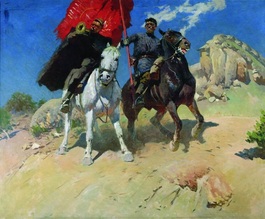
Trumpeter and standard-bearer by M. Grekov
Thomas Sanders ([email protected])
The article examines the theory and practice of Soviet art management. The primary area of interest is cinematic art, although the aesthetic principles that governed film production also applied to the other artistic fields. Fundamental to an understanding of Soviet art management is the elucidation of Marxist-Leninist interpretation of the role of art as part of a society’s superstructure, and the contrast defined by Soviet Marxist-Leninists between “socialist” art (i.e., that of Soviet society) and the art of bourgeois, capitalist social systems. Moreover, this piece also explores the systems utilized to manage Soviet art production—the control and censorship methods and the material incentives. (Paper in English)
The article examines the theory and practice of Soviet art management. The primary area of interest is cinematic art, although the aesthetic principles that governed film production also applied to the other artistic fields. Fundamental to an understanding of Soviet art management is the elucidation of Marxist-Leninist interpretation of the role of art as part of a society’s superstructure, and the contrast defined by Soviet Marxist-Leninists between “socialist” art (i.e., that of Soviet society) and the art of bourgeois, capitalist social systems. Moreover, this piece also explores the systems utilized to manage Soviet art production—the control and censorship methods and the material incentives. (Paper in English)
La Construcció de l'ideal de feminitat anarquista en Generación consciente
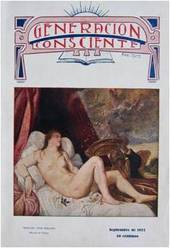
Generación Consciente magazine
Anaïs Siscar i Carrió ([email protected])
By analysing the monthly anarchist review Generación Consciente, this paper approaches the delimitation of the femininity ideal underlying the discourse of an important part of the Iberian anarchism. Representing the period when the neomalthusian ideas are added to the anarchist program, Generación Consciente also creates an educational discourse destined to achieve what its creators were going to call the “conscious maternity”. The main goal was the transformation of the existent female roles and their adaptation to the libertarian project. To understand the context in which this publication was developed it needs to be placed within the intersection of a range of historical phenomena that determined its discourse and made it a paradigmatic product of its time. (Paper in Catalan)
By analysing the monthly anarchist review Generación Consciente, this paper approaches the delimitation of the femininity ideal underlying the discourse of an important part of the Iberian anarchism. Representing the period when the neomalthusian ideas are added to the anarchist program, Generación Consciente also creates an educational discourse destined to achieve what its creators were going to call the “conscious maternity”. The main goal was the transformation of the existent female roles and their adaptation to the libertarian project. To understand the context in which this publication was developed it needs to be placed within the intersection of a range of historical phenomena that determined its discourse and made it a paradigmatic product of its time. (Paper in Catalan)
La "crisis de adaptación" en las sociedades africanas tras el final de la trata de esclavos: el caso de casamance como respuesta dual
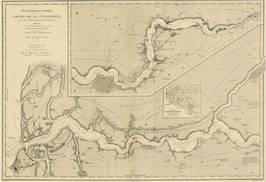
The Casamance region in southern Senegal
Eric Garcia Moral ([email protected])
This paper examines the academic debates about the impact of the end of the Atlantic slave trade on African societies. Special attention is given to the idea of “adaptation crisis” of the old elites who monopolized the slave supply and sale as well as to the effects caused by the introduction of the so called “fair” trade of agrarian products, specifically the peanut. The Casamance region in southern Senegal is taken as the setting for the analysis of the above-mentioned topics. In this particular case, there was a kind of dual situation within the region: an “adaptation crisis” materialized in the inner mandinga area, but not in the Atlantic shore, mainly inhabited by diolas. (Paper in Spanish)
This paper examines the academic debates about the impact of the end of the Atlantic slave trade on African societies. Special attention is given to the idea of “adaptation crisis” of the old elites who monopolized the slave supply and sale as well as to the effects caused by the introduction of the so called “fair” trade of agrarian products, specifically the peanut. The Casamance region in southern Senegal is taken as the setting for the analysis of the above-mentioned topics. In this particular case, there was a kind of dual situation within the region: an “adaptation crisis” materialized in the inner mandinga area, but not in the Atlantic shore, mainly inhabited by diolas. (Paper in Spanish)
La religión de humayun
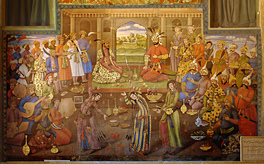
Emperor Humayun and shah Tahmasp in 1543
Marc Morató-Aragonés Ibáñez ([email protected])
Humayun (1508-1556), the second Mughal ruler of India, is well known for his conversion to Shiism during his exile in Persia, a conversion that he reverted after becoming the ruler of Delhi for the second time. Despite his longevity, Humayun could not enjoy too much of his kingdom. Facing the rebellion of his brothers and the pressure from leaders like Bahadur Shah of Gujarat and Sher Khan Sur of Afghans he had to seek refuge at the court of Safavid Shah Tahmasp, where his host pressed him to become Shiite—a move that Humayun tactically accepted. This paper aims to find out to what extent the return to Sunnism was important to Humayun and which role religion played in political relations of the sovereign and the court. (Paper in Spanish)
Humayun (1508-1556), the second Mughal ruler of India, is well known for his conversion to Shiism during his exile in Persia, a conversion that he reverted after becoming the ruler of Delhi for the second time. Despite his longevity, Humayun could not enjoy too much of his kingdom. Facing the rebellion of his brothers and the pressure from leaders like Bahadur Shah of Gujarat and Sher Khan Sur of Afghans he had to seek refuge at the court of Safavid Shah Tahmasp, where his host pressed him to become Shiite—a move that Humayun tactically accepted. This paper aims to find out to what extent the return to Sunnism was important to Humayun and which role religion played in political relations of the sovereign and the court. (Paper in Spanish)
polítiques identitàries dels eua a okinawa 1945-1972 aproximació a les causes del seu fracàs
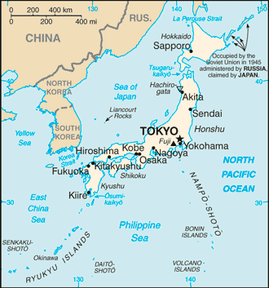
Map of Japan
Marçal Sanmartí Giménez ([email protected])
In April 1945 the US Army started the occupation of Okinawa archipelago that lasted for almost twenty years. During this period, US authorities developed a series of identity policies that were applied to the people of Okinawa in order to create a national identity separate from the Japanese one. These efforts were, however, not successful. What were these policies? For what purpose were they created? Why did these policies fail? This article aims to answer these questions. (Paper in Catalan)
In April 1945 the US Army started the occupation of Okinawa archipelago that lasted for almost twenty years. During this period, US authorities developed a series of identity policies that were applied to the people of Okinawa in order to create a national identity separate from the Japanese one. These efforts were, however, not successful. What were these policies? For what purpose were they created? Why did these policies fail? This article aims to answer these questions. (Paper in Catalan)
ESSAYS
japón en la historia del mundo
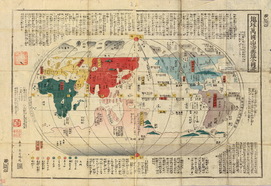
Japanese world map
Alfonso Falero ([email protected])
The following essay examines the progress and the obstacles still present in developing a global history of Japan by offering an extensive annotated outline of James L. Huffman’s book Japan in World History. The author uses the principal bibliography on the new global history to offer new ways to connect Japanese history with the world. (Paper in Spanish)
The following essay examines the progress and the obstacles still present in developing a global history of Japan by offering an extensive annotated outline of James L. Huffman’s book Japan in World History. The author uses the principal bibliography on the new global history to offer new ways to connect Japanese history with the world. (Paper in Spanish)
paz y exilio. el franquismo y la derrota del nacionalismo catalán vistos a través de antoni rovira i virgili (1939-1949)
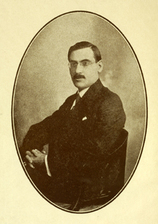
Antoni Rovira i Virgili
M. Carmen Riu de Martín ([email protected])
The journalist, politician and writer Antoni Rovira i Virgili was an outstanding supporter of the left-wing Catalan nationalism. He had to emigrate to France after the fall of the Second Spanish Republic, both because of his political ideas and his direct participation in the government of Catalonia. His books, articles and poems written between 1939 and 1949 offer an extraordinary source to understand his ideology and see the origins of the profound nostalgia towards his homeland caused by the exile. (Paper in Spanish)
The journalist, politician and writer Antoni Rovira i Virgili was an outstanding supporter of the left-wing Catalan nationalism. He had to emigrate to France after the fall of the Second Spanish Republic, both because of his political ideas and his direct participation in the government of Catalonia. His books, articles and poems written between 1939 and 1949 offer an extraordinary source to understand his ideology and see the origins of the profound nostalgia towards his homeland caused by the exile. (Paper in Spanish)
Book reviews
Yu Hua, China en diez palabras, reviewed by Oriol Regué Sendrós ([email protected])
Bernal Díaz del Castillo, Historia verdadera de la conquista de la Nueva España & Christian Duverger, Crónica de la eternidad. Quién escribió la Historia verdadera de la conquista de la Nueva España?, reviewed by Alfonso Colorado ([email protected])
Bernal Díaz del Castillo, Historia verdadera de la conquista de la Nueva España & Christian Duverger, Crónica de la eternidad. Quién escribió la Historia verdadera de la conquista de la Nueva España?, reviewed by Alfonso Colorado ([email protected])

